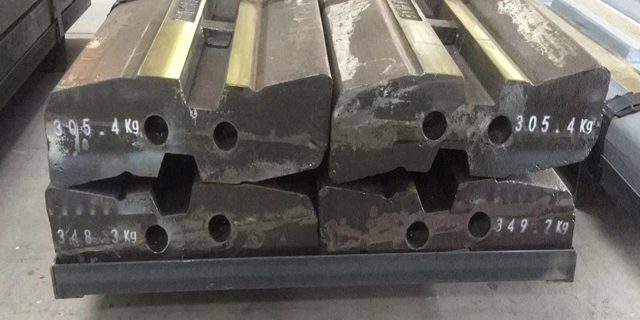Crusher blow bars, also known as impact crusher blow bars or hammers, are key components in an impact crusher crushing chamber. They are essential parts that come into direct contact with the material being crushed and play a crucial role in the crushing process.
- Impact Crushing: Impact crushers are machines that crush materials by applying forceful impacts. Blow bars are responsible for delivering the impact force to the material. When the rotor of the impact crusher spins, the blow bars strike the material, breaking it into smaller pieces.
- Wear Resistance: Blow bars are typically made from durable and wear-resistant materials, such as high-manganese steel, martensitic steel, chrome steel, or ceramic inserts. These materials are chosen for their ability to withstand the abrasive nature of the crushing process and resist wear and tear.
- Impact Strength: Blow bars must possess the necessary impact strength to fracture the material effectively. They need to endure repeated high-velocity impacts without deforming or breaking themselves.
- Impact Crusher Performance: The design, material composition, and configuration of blow bars directly affect the performance of an impact crusher. Properly selected blow bars can result in better particle size reduction, higher production rates, and improved product quality.
- Application-Specific: Different applications may require different types of blow bars. For instance, crushing highly abrasive materials like granite may call for different blow bar materials and designs than recycling concrete or crushing softer aggregates.
- Maintenance and Replacement: Blow bars are subject to wear and will eventually need replacement. Regular inspection and maintenance are essential to ensure optimal performance and to replace worn or damaged blow bars promptly.
Factors affecting the wear of blow bars
The wear of blow bars in impact crushers is influenced by various factors, and understanding these factors can help in optimizing their performance and lifespan. Here are the key factors that affect the wear of blow bars:
- Rotor speed
- Feed size
- Crusher Configuration
- Pre-screening
- Crushing ratio
- Feed material
The specifics of the influencing factors and how they relate to each other |
|
| Influencing factors | Specifics of the factors |
| Rotor Speed | Theoretically, the rotor speed is regulated according to the material flow and the quality of the finished product. In general, the faster the rotor speed, the easier it is for the hammers to wear out. |
| Feed Size | Any incorrect adjustment of the opening ratio will increase the wear of the hammers and damage the machine. On the other hand, to ensure smooth material flow and feeding in the crushing chamber, the ratio of the opening gap between the upper and lower impact plates must be set correctly. In general, the lower opening should be the same size as the final material and the upper opening should be 30% of the maximum feed size. |
| Crusher Configuration | Rotors are generally designed for two-plate hammers, three-plate hammers and four-plate hammers. The size of the crushed material usually determines the rotor’s hammer equipment. If the rotor speed is provided, the wear of the hammers, liners and impactors will increase accordingly. Hammer and rotor speeds must be adequately matched to the feed material to minimize wear and ensure the quality of the final material. |
| Pre-screening | Pre-screening reduces wear by minimizing the inflow of contaminants that can accumulate in the crusher. |
| Crushing Ratio | The ratio of the feed size to the discharge size is called the maximum crushing ratio and depends mainly on the physical properties of the feed material. |
| Feed Material | The composition of the crushed material is the most important factor in the wear of the hammer. Crushing materials must be fully understood and analyzed to choose the right material for the hammers to achieve the longest service life. |



